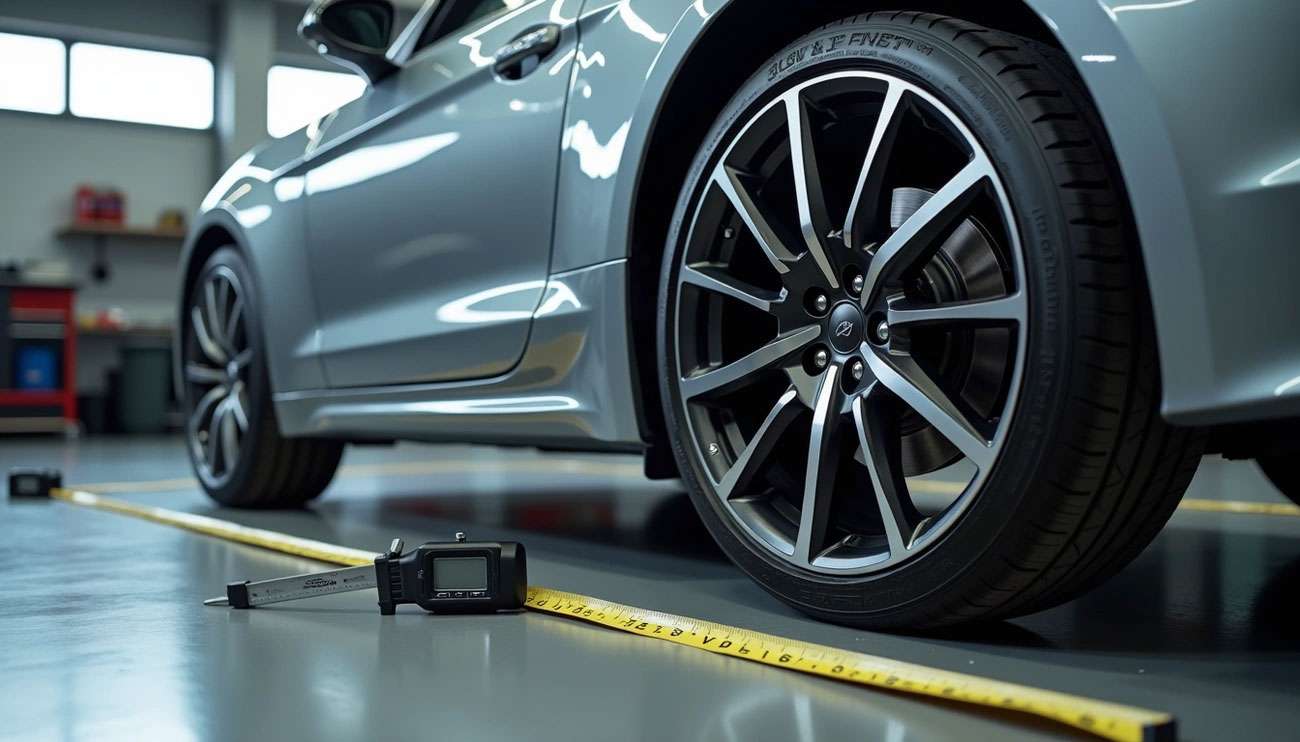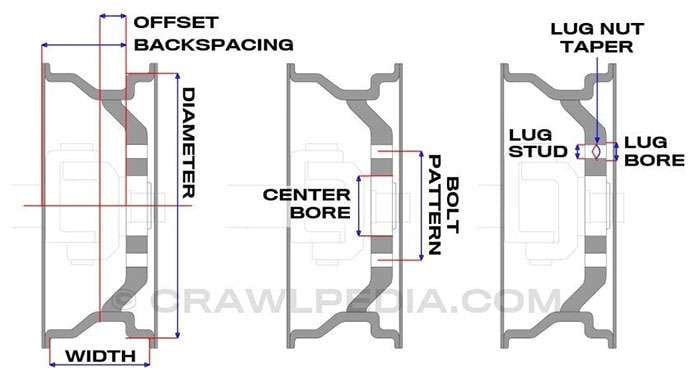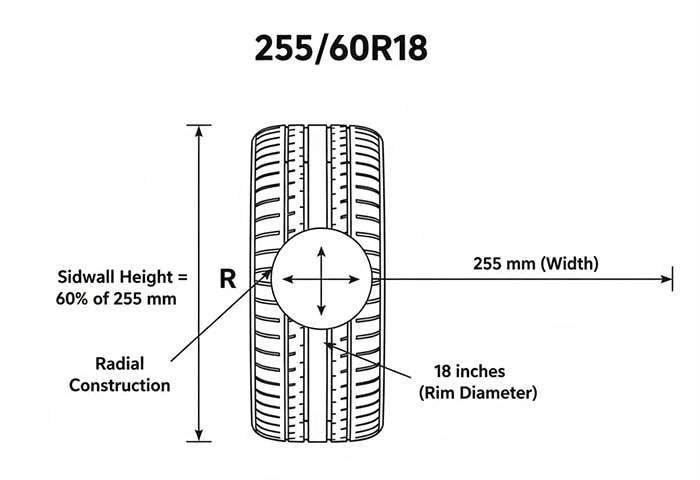
Car wheel sizes directly impact how your vehicle handles, looks, and performs on the road. Regular road cars typically feature wheels ranging between 14 and 21 inches in diameter. The size you choose makes a significant difference in your driving experience and vehicle appearance.
Wheel diameter represents just one part of the equation. Width, offset, and bolt pattern all determine whether wheels will properly fit your vehicle. Most vehicles use a 4-, 5-, 6-, or 8-lug pattern, and car manufacturers have utilized over 30 different bolt patterns throughout the years. Larger wheels create increased contact with the pavement, providing your vehicle with more grip and improved handling capabilities.
Wheel size specifications follow a standard format. The listing starts with diameter, followed by width, and concludes with offset. When you see a marking like "ET30" on your wheel, this indicates the hub face sits 30mm outward from the center of the wheel width.
Understanding these measurements becomes essential when selecting new wheels for your vehicle. We'll guide you through everything you need to know about different wheel sizes, helping you find the perfect match for your performance requirements and style preferences.
Wheel size affects nearly every aspect of your vehicle's road performance. Each size offers specific advantages and trade-offs that directly impact your driving experience.
Larger wheels with low-profile tires deliver superior stability and grip through increased pavement contact area. This improved handling comes with a significant drawback: a noticeably stiffer, less comfortable ride. Low-profile tires with shorter sidewalls transmit road bumps and vibrations directly to your suspension and cabin.
Smaller wheels with taller sidewalls provide substantially better comfort by absorbing road imperfections more effectively. The taller sidewalls flex over bumps, cushioning impacts and protecting your rims from pothole damage. Larger wheels also increase unsprung weight, forcing your suspension to work harder and potentially causing accelerated wear.
Wheel size dramatically transforms your vehicle's appearance. Larger wheels create a commanding presence, emphasizing sportiness or elegance. Many drivers select larger wheels primarily for their visual impact, achieving a more aggressive stance that makes vehicles stand out.
Smaller wheels offer a classic, understated appearance. Your wheel choice reflects your personal style and the image you want to project on the road.
Wheel size directly affects performance metrics beyond appearance and comfort. Larger wheels can reduce acceleration performance—testing revealed that upgrading from 15-inch to 19-inch wheels increased 0-60 mph times from 7.6 to 7.9 seconds. Braking performance also suffers, with a 10% wheel diameter increase resulting in approximately 10% reduced braking effectiveness.
Fuel consumption rises with larger wheels. City driving with 19-inch wheels consumes about 10% more fuel compared to 15-inch wheels. Larger, heavier wheels increase rolling resistance, requiring your engine to work harder maintaining speed. Highway driving at consistent speeds shows less noticeable fuel differences.
The ideal wheel size depends on your priorities. Handling enthusiasts may choose larger wheels despite comfort sacrifices, while those prioritizing comfort and efficiency often select smaller options.
Understanding wheel measurements is important before making a purchase. The numbers and letters on your car wheels contain essential information about compatibility and performance. Once you learn the basics, identifying the right wheels for your vehicle becomes straightforward.
Three key measurements determine wheel fitment. Wheel diameter measures straight across the wheel face from bead seat to bead seat, expressed in inches. This measurement excludes the outer lips and determines which tire sizes will fit.
Width measures the distance between inner bead seats where the tire mounts, also expressed in inches. Wider wheels allow for wider tires, affecting the contact patch and handling characteristics.
Offset represents the distance between the wheel's mounting surface and centerline, measured in millimeters. Positive offset pushes wheels inward toward the vehicle, common in front-wheel-drive cars. Negative offset pushes them outward, creating the popular "deep dish" appearance. Zero offset aligns the mounting surface directly with the centerline.
Finding your current wheel specifications requires checking several locations:
Stamped on the back of the wheel hub, often on one of the spokes
Inside the driver's door frame
Your vehicle's owner manual
Current tire sidewalls
Wheel markings typically appear on the back of the hub. You might need to use your smartphone camera to capture the information if the markings aren't easily visible.
A typical wheel marking like '7.5Jx16H2 ET35' contains specific technical information:
7.5: Wheel width in inches
J: Tire bead profile type defining the wheel collar profile
16: Wheel diameter in inches
H2: Wheel rim section profile indicating hump design for wheel stiffness
ET35: Offset of 35mm (ET derives from German "einpresstiefe" meaning insertion depth)
These codes provide vital structural information that directly impacts performance and fitment. Understanding these markings helps prevent issues with handling, tire wear, and safety concerns.

Image Source: Crawlpedia
Three critical technical factors determine proper wheel fitment beyond basic measurements. These specifications ensure your wheels mount correctly and perform safely on your vehicle.
Offset measures the distance in millimeters from the wheel's centerline to its mounting surface. This measurement controls how your wheels sit in the wheel wells. Zero offset aligns the mounting surface perfectly with the centerline. Positive offset moves the mounting surface toward the street side, which is common in front-wheel drive vehicles. Negative offset positions the mounting surface behind the centerline, creating the popular "deep dish" appearance.
Incorrect offset causes serious problems. Poor handling, excessive wear on suspension components, and potential fender interference all result from choosing the wrong offset specifications.
Bolt pattern, or Pitch Circle Diameter (PCD), represents the diameter of an imaginary circle passing through the center of all wheel studs or bolt holes. The measurement appears as the number of lugs followed by the diameter (example: 5/114.3).
For 4-lug wheels, measure directly across opposing holes. For 5-lug patterns, measure from the inside of one hole to the outside of the next hole and multiply by 1.7012 to calculate PCD.
Hub-centric wheels center themselves on the vehicle's hub, creating a perfect match between the wheel's center bore and hub diameter. Original equipment wheels are typically hub-centric, offering optimal weight distribution and reduced vibration.
Lug-centric wheels center using the lug nuts, making them more versatile for aftermarket applications but potentially less precise in fitment.
Spigot rings (hub-centric rings) solve discrepancies between larger wheel center bores and smaller vehicle hub diameters. These plastic or metal adapters ensure proper wheel centering, eliminating vibrations that could damage wheels or compromise safety.
Installing the correct size ring centralizes the wheel, prevents stress on wheel bolts, and ensures the wheel spins true to the vehicle.

Selecting the optimal wheel size for your vehicle requires balancing performance, safety, and appearance considerations. The right choice depends on your driving priorities and vehicle requirements.
Wheel diameter must match tire diameter exactly—you can only mount a 16" tire on a 16" wheel. The wheel width directly affects your tire's contact patch and handling characteristics. When changing rim width, adjust tire width by approximately 1/5" for each 1/2" change in rim width. This maintains the tire's structural integrity and ensures proper performance.
Rolling radius consistency is essential for vehicle systems to function properly. Changes exceeding 3% from original equipment specifications affect speedometer accuracy, anti-lock brakes, and stability systems. All-wheel or four-wheel drive vehicles require even more precision—mismatched rolling radii create continuous strain on driveline components. Rolling radius responds more to tire brand and inflation pressure than to tread depth.
Vehicle safety regulations specify that improper tire sizing can void manufacturer warranties and potentially violate local laws. Changing wheel size affects suspension geometry, braking distances, and fuel efficiency. Larger wheels increase stress on suspension components and can reduce fuel economy by up to 10% in city driving. Find your Car Wheels Today from trusted providers who understand these technical requirements and can ensure proper fitment.
Staggered fitment—using wider wheels and tires on one axle—works best for rear-wheel drive performance vehicles. This setup improves acceleration grip and handling through increased rear contact patch. However, staggered configurations prevent traditional tire rotation patterns and increase long-term costs. Front-wheel drive vehicles should avoid staggered setups as they can reduce handling performance.
When selecting wheel sizes, consider your driving habits, terrain conditions, and performance priorities. The perfect wheel size balances your specific needs with safety requirements and vehicle compatibility.
Selecting the right wheel size comes down to understanding your priorities and making informed choices. Wheel dimensions affect every aspect of your vehicle's performance, from handling and fuel efficiency to ride comfort and appearance. Larger wheels deliver better grip and bold styling, while smaller wheels provide superior comfort, fuel economy, and protection from road hazards.
The technical aspects we've covered—diameter, width, offset, bolt pattern, and center bore—determine proper fitment and safety. These measurements ensure your wheels work correctly with your vehicle's systems and provide optimal performance. Maintaining proper rolling radius prevents problems with electronic systems and drivetrain components.
Some drivers choose wheels based purely on looks, potentially sacrificing comfort and efficiency. Others focus on performance gains while accepting trade-offs in ride quality. Your driving habits, typical road conditions, and personal preferences should guide your decision. Whether you want sporty handling or maximum comfort, Find your Car Wheels Today from experts who understand these technical requirements.
At Performance Plus Tire, we believe the perfect wheel size exists for every driver and every vehicle. Our knowledgeable team can help you balance style, performance, and practicality to find the ideal solution for your specific needs.
Understanding wheel sizes is crucial for optimizing your vehicle's performance, safety, and appearance. Here are the essential insights every car owner should know:
• Wheel size directly impacts performance trade-offs: Larger wheels (17-21") improve handling and grip but reduce comfort and fuel efficiency by up to 10%, while smaller wheels (14-16") provide better ride quality and fuel economy.
• Read wheel markings correctly: A marking like "7.5Jx16H2 ET35" indicates 7.5" width, 16" diameter, and 35mm offset—critical measurements for proper fitment and safety.
• Three key fitment factors ensure compatibility: Offset (wheel position), bolt pattern (lug configuration), and center bore (hub diameter) must match your vehicle's specifications to prevent handling issues and component damage.
• Maintain proper rolling radius when upgrading: Changes exceeding 3% from original specifications can affect speedometer accuracy, ABS systems, and drivetrain components, especially in AWD vehicles.
• Consider your driving priorities before choosing: Performance enthusiasts may prefer larger wheels despite comfort trade-offs, while daily commuters benefit from smaller wheels that offer better fuel economy and pothole protection.
The perfect wheel size balances your esthetic preferences with practical considerations like comfort, efficiency, and maintenance costs. Always consult fitment specialists to ensure compatibility and safety when upgrading from factory specifications.
Regular road cars generally have wheels ranging from 14 to 21 inches in diameter. Larger wheels (17-21 inches) improve handling and grip but may reduce comfort and fuel efficiency, while smaller wheels (14-16 inches) offer better ride quality and fuel economy.
Wheel size markings like "7.5Jx16H2 ET35" indicate the wheel's width (7.5 inches), diameter (16 inches), and offset (35mm). Understanding these markings is crucial for ensuring proper fitment and performance.
Consider your driving priorities, road conditions, and personal preferences. Larger wheels generally provide better grip and esthetics, while smaller wheels offer superior comfort, fuel economy, and protection against road damage. Also, ensure the wheel size maintains the correct rolling radius to prevent issues with vehicle systems.
While it's possible to use different wheel sizes, it's important to maintain the correct overall diameter to avoid affecting speedometer accuracy and vehicle systems. Always consult with a specialist to ensure compatibility and safety when changing wheel sizes.
Larger wheels can decrease fuel efficiency, especially in city driving. For example, 19-inch wheels may use about 10% more fuel compared to 15-inch wheels due to increased rolling resistance. However, this difference may be less noticeable during highway driving at consistent speeds.